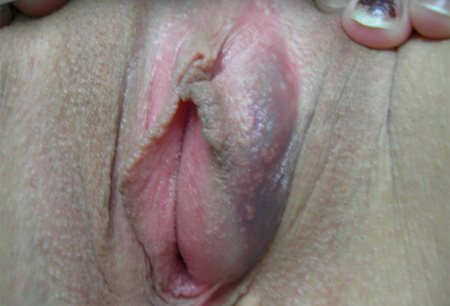Case history
Case history #1
A 22-year-old nulliparous woman presents with vulval pain and swelling. She noted sudden onset of swelling with increasing discomfort after sexual intercourse several days before. Her partner is asymptomatic. She denies any history of sexually transmitted infections (STIs). Her general exam is unremarkable and she is afebrile. On vulval exam, a swelling is noted at the medial aspect of the labia and introitus with the labium minus transecting the cystic mass. [Figure caption and citation for the preceding image starts]: Bartholin's cystFrom the personal collection of Colleen Kennedy Stockdale [Citation ends]. There is no palpable groin adenopathy. No lesions or excoriations are present. The cyst is mildly tender to palpation. Vaginal speculum exam reveals normal-appearing mucosa without significant discharge.
There is no palpable groin adenopathy. No lesions or excoriations are present. The cyst is mildly tender to palpation. Vaginal speculum exam reveals normal-appearing mucosa without significant discharge.
Case history #2
A 32-year-old nulliparous woman presents with severe vulval pain and swelling. She has had increasing pain over the last day unrelieved by oral analgesics (paracetamol). She denies any history of STIs, and her partner is asymptomatic. On exam, the patient is in severe discomfort and finding it difficult to sit down. She is mildly pyrexial. On vulval exam the left vulva is erythematous with swelling of the medial aspect and introitus, with the labium minus transecting a cystic swelling. [Figure caption and citation for the preceding image starts]: Bartholin's abscess: erythema, oedema, with cyst abscess posterior to labia minoraFrom the personal collection of Colleen Kennedy Stockdale [Citation ends]. There is no involvement of the distal vagina and no palpable groin adenopathy. No lesions or excoriations are present. The cyst is very tender to palpation, and the patient is unable to tolerate speculum insertion for vaginal inspection.
There is no involvement of the distal vagina and no palpable groin adenopathy. No lesions or excoriations are present. The cyst is very tender to palpation, and the patient is unable to tolerate speculum insertion for vaginal inspection.
Other presentations
Bartholin's cyst may be bilateral, and there may be concurrent vulval disorders (e.g., contact dermatitis, lichen simplex, other dermatoses), non-cystic tumours (benign or malignant neoplasms), or, rarely, fistula. Occasionally, cysts dissect anterolaterally into the labia majora.[2]
The incidence of Bartholin's neoplasm is low (<1 in 500,000 women) but should be considered in post-menopausal women, any non-cystic lesions, or any cyst with an atypical appearance.[3][Figure caption and citation for the preceding image starts]: Squamous cell cancerFrom the personal collection of Colleen Kennedy Stockdale [Citation ends]. Reports of Bartholin's rectal fistula are rare.[4][5] However, the occurrence of fistula should be considered in women presenting with persistent purulent drainage and granulation tissue involving Bartholin's duct.
Reports of Bartholin's rectal fistula are rare.[4][5] However, the occurrence of fistula should be considered in women presenting with persistent purulent drainage and granulation tissue involving Bartholin's duct.
Use of this content is subject to our disclaimer